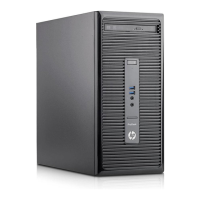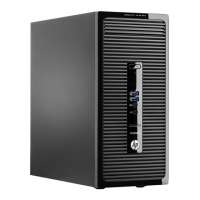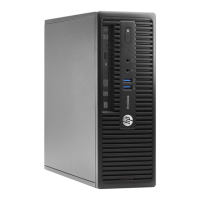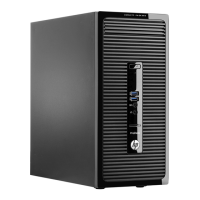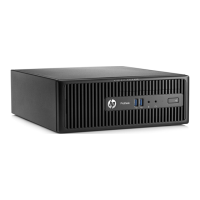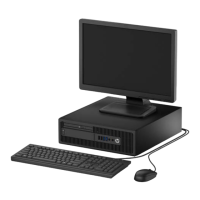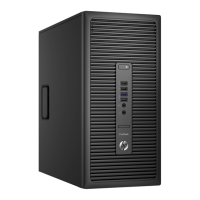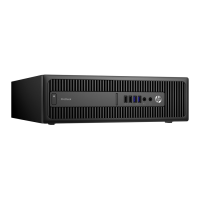
Do you have a question about the HP ProDesk 490 G2 and is the answer not in the manual?
| Tcase | 72 °C |
|---|---|
| Bus type | DMI2 |
| Stepping | C0 |
| Processor cache | 3 MB |
| Processor cores | 2 |
| System bus rate | 5 GT/s |
| Processor family | Intel® Core™ i3 |
| Processor series | Intel Core i3-4100 Desktop series |
| Processor socket | LGA 1150 (Socket H3) |
| Processor threads | 4 |
| Processor codename | Haswell |
| Number of QPI links | 0 |
| Processor frequency | 3.7 GHz |
| Processor cache type | L3 |
| Processor lithography | 22 nm |
| Processor manufacturer | Intel |
| Processor front side bus | - MHz |
| PCI Express slots version | 3.0 |
| Processor operating modes | 32-bit, 64-bit |
| ECC supported by processor | Yes |
| PCI Express configurations | 1x16, 2x8, 1x8+2x4 |
| Thermal Design Power (TDP) | 54 W |
| Number of processors installed | 1 |
| Maximum number of PCI Express lanes | 16 |
| Memory types supported by processor | DDR3-SDRAM, DDR3L-SDRAM |
| Memory voltage supported by processor | 1.5 V |
| Memory clock speeds supported by processor | 1333, 1600 MHz |
| Memory bandwidth supported by processor (max) | 25.6 GB/s |
| Maximum internal memory supported by processor | 32 GB |
| On-board graphics card ID | 41 |
| Discrete graphics card model | Not available |
| On-board graphics card model | Intel® HD Graphics 4400 |
| On-board graphics card family | Intel® HD Graphics |
| Maximum on-board graphics card memory | 1.74 GB |
| On-board graphics card OpenGL version | 4.3 |
| On-board graphics card base frequency | 350 MHz |
| On-board graphics card DirectX version | 11.1 |
| On-board graphics card dynamic frequency (max) | 1150 MHz |
| Number of displays supported (on-board graphics) | 3 |
| Memory slots | 4x DIMM |
| Internal memory | 4 GB |
| Memory channels | Dual-channel |
| Memory clock speed | 1600 MHz |
| Internal memory type | DDR3-SDRAM |
| Memory layout (slots x size) | 1 x 4 GB |
| HDD speed | 7200 RPM |
| HDD interface | SATA |
| Storage media | HDD |
| Optical drive type | DVD±RW |
| Total storage capacity | 500 GB |
| Intel segment tagging | Enterprise, Small Business |
| Operating system installed | FreeDOS |
| Operating system architecture | 64-bit |
| Wi-Fi | No |
| Cabling technology | 10/100/1000Base-T(X) |
| Ethernet LAN data rates | 10, 100, 1000 Mbit/s |
| USB 2.0 ports quantity | USB 2.0 ports have a data transmission speed of 480 Mbps, and are backwards compatible with USB 1.1 ports. You can connect all kinds of peripheral devices to them. |
| Chassis type | Micro Tower |
| Product color | Black |
| Country of origin | China |
| Placement supported | Vertical |
| Product type | PC |
| Motherboard chipset | Intel® H97 |
| Power supply | 180 W |
| Power supply input voltage | 100 - 240 V |
| Power supply input frequency | 50 - 60 Hz |
| Operating temperature (T-T) | 10 - 35 °C |
| Operating relative humidity (H-H) | 10 - 90 % |
| Sustainability certificates | ENERGY STAR |
| Scalability | 1S |
| Processor code | SR1PL |
| Processor ARK ID | 77490 |
| Processor package size | 37.5 x 37.5 mm |
| Supported instruction sets | AVX 2.0, SSE4.1, SSE4.2 |
| Thermal solution specification | PCG 2013C |
| Intel Secure Key Technology version | 1.00 |
| Intel Stable Image Platform Program (SIPP) version | 0.00 |
| Depth | 358.8 mm |
|---|---|
| Width | 165 mm |
| Height | 355 mm |
| Weight | 6500 g |
Overview of the standard hardware and software features available on the computer model.
Steps for activating the operating system and customizing software settings for Windows 7.
Steps for activating the operating system and customizing software settings for Windows 8.
Explanation of electrostatic discharge and its potential to damage electronic components.
Precautions and methods to prevent damage from static electricity during handling.
Information on memory modules, installation, and configuration for optimal performance.
Procedures for installing and removing hard drives and optical drives.
Security features including setup passwords, device security, and USB security settings.
Common causes and solutions for general computer operational issues.
Troubleshooting steps for hard drive errors, disk transactions, and recognition issues.
Troubleshooting steps for blank screens, blurry video, and image display issues.
Solutions for issues with keyboard commands, typing, and mouse responsiveness.
Solutions for common software issues like application errors and system startup failures.
Troubleshooting steps for network connectivity, driver detection, and status light issues.
Solutions for issues related to memory installation, errors, and insufficient memory.
Troubleshooting steps for processor overheating, seating, and compatibility issues.
List of POST errors with numeric codes, descriptions, and recommended actions.
Guide to understanding front panel LED and audible codes for POST diagnostics.
Procedure for clearing passwords by resetting the CMOS using a jumper.
Instructions for resetting CMOS values to factory defaults.
Guides for safeguarding information and returning Windows 8.1/8 to a working state.
Guides for safeguarding information and returning Windows 7 to a working state.
Procedures for completely erasing and reinstalling the operating system.


